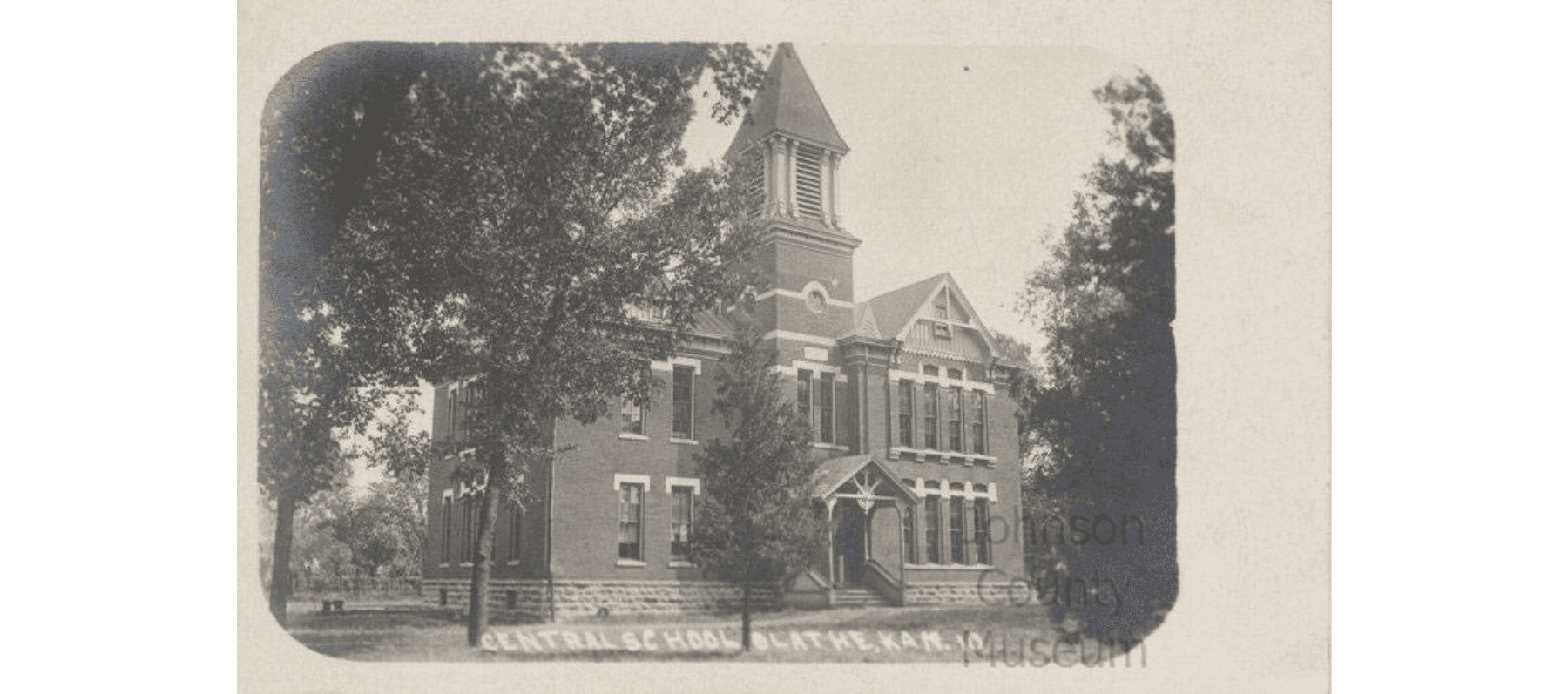
This article is from Johnson County Library’s Vertical Files. It was originally written by Lois Nettleship in 1980. It has been edited for length and clarity.
Olathe was founded in 1857 and became the seat of Johnson County in 1858. Its early settlers came seeking land and economic opportunity. The land had been a reservation for the Shawnee Tribe, but before the Civil War the Shawnee ceded all but 2,000 of their original 600,000 acres. After the war, they sold their remaining acreage to speculators who in turn sold it to settlers. Although the town suffered depredations at the hands of Quantrill and his raiders during the Civil War, it quickly recovered, and its population increased and prospered. Between 1865 and 1900, the population of Olathe grew to 3,500 where it remained until the 1930s.

The land around Olathe has been productive farm land, divided into moderate sized farms producing such crops as wheat, corn, oats, alfalfa, and potatoes. The town itself serviced the surrounding farms with such businesses as banks, insurance agencies, hardware, dry goods, mills, and railroad depots. Olathe was also the site of the Olathe Fairview Race Course, the Hyer boot factory, a short-lived rubber factory, and the main branch of the Grange department store. The town became the home of the Johnson County Court House and the Kansas State School for the Deaf, established in 1861.

By the turn of the century, the Atchison, Topeka, and Santa Fe and the St. Louis and San Francisco railroads operated regular passenger service between Kansas City and Olathe. In 1907, the Missouri and Kansas Inter-Urban Electric Railway (Strang Line) began running cars between the two towns several times a day. The ride took about ninety minutes. As a result of this connection, a souvenir book of the day described Olathe as, “…admirably situated to suit the requirements of business men in the larger city who desire to make their homes amid rural surroundings, free from the objectionable features of metropolitan life, yet where they will find schools, churches, and social advantages.” (Souvenir Book of Olathe and Johnson County, F.S. Mickey, ed., p. 7)

Schools, churches, and other such institutions were important to Olathans in maintaining these standards. In addition to its own school system, the town in the early 1900s had three newspapers, several Protestant churches, a Catholic church, and a chapter of the Masons, the Grand Army of the Republic, and the Federated Women’s Clubs. There was also an independent Chataqua and a Ladies Reading Circle which aided in founding the Olathe Public Library in 1914. Olathe was a small but complete town, having its own businesses, cultural institutions, churches, and schools.
Olathe’s first public school was held in 1862 at different places in town, among them the Masonic Hall and the Methodist church. It was open to pupils ages five to twenty-one. In 1868, six years before Olathe was organized into a school district, the town built its first permanent school building at a cost of $10,000. It was a substantial two story stone structure, known as the Stone School, which reportedly accommodated four teachers and some 175 pupils. It was probably this school which George Washington Carver attended for two years. In 1883, Central Grade School opened. In 1889, two smaller grade schools opened, Washington and Lincoln. Both Washington and Central are in operation today, though at different locations. Lincoln was for Black pupils, and after moving to a new building in 1917, was closed in the 1950s when Olathe elementary schools were integrated.

Olathe High School started its operation at the Stone School in 1880, with a two year college preparatory course which offered German, Latin, English, history, and mathematics. In 1891, the high school expanded its course of study to three years, and in 1903, to four years. In 1898, the high school moved into a new building which cost $15,000 to build, and the Stone School was demolished. It remained in this new building until the 1920s when another building was constructed. In the early 1900s, the high school offered both a college preparatory course for students not intending to go on to college or teaching. By 1910, the high school was offering agriculture, domestic science, and manual training classes. Olathe High School gained accreditation from the North Central Association of Colleges and High Schools in 1911, and was then the only high school of the ten in Johnson County to be so accredited.

In 1898, the enrollment at the high school was 120. This increased during the next several years, and by 1920 was 265. The high school was racially integrated. More than half the graduates of the classes during the 1910 to 1920 period were women. According to the 1920 Olathe High School Yearbook, most of the women graduates wanted to become teachers, clerks, and stenographers, while most of the men wanted to become farmers, engineers, lawyers, doctors, and bankers.
In summary, during the early twentieth century, the town of Olathe, a small farm marketing town in a rich agricultural county, took education seriously. Its inhabitants were willing to tax themselves and their businesses to pay for it. Olathans considered schools to be citizen builders.
-Lois Nettleship




